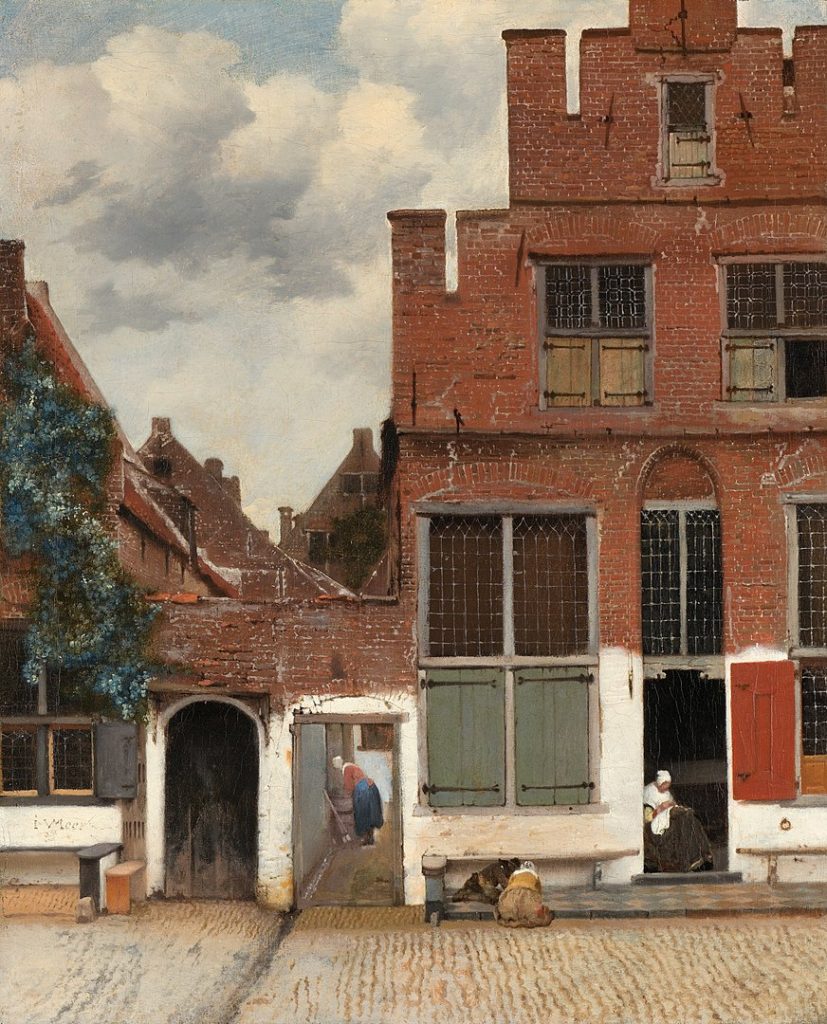The Little Street
Last month, I chose Arthur Hacker’s Imprisoned Spring (1900) as my Painting of the Month, a view of a young woman looking out at nature through a window. This month I wanted to pick something to reflect the slight easing of lockdown, inspired by walks around my neighbourhood. As we are all spending more time in our homes, we may be taking the opportunity to do long put-off chores or just sit in a sunny spot in front of a window or open door. It seems we must all turn our minds inwards and to our locality, and there is something very grounding about realising this. The Little Street (1657-8) is a seemingly quotidian scene, one which gives us a glimpse into another time and place while simultaneously resonating with life today. While Johannes Vermeer (1632-75) is famous for his paintings of interiors and the quietude of individual, albeit anonymous, domestic activity, a couple of his works capture his deeply rooted connection to his hometown of Delft, while retaining that distinct elusiveness.
While walking around familiar residential streets, I find myself looking into other people’s houses for human activity in homes and gardens. People, like the figures in this scene, are absorbed in their tasks while the observer passes by quickly and unnoticed. In this snapshot of Vermeer’s, the clouds in the sky suggest movement but the women at work and the children at play have been frozen in time. It was only fairly recently that the address of this painting was identified. Thanks to the fidelity to which Vermeer captured the scene, using archival documents and Google Maps, Professor Frans Grijzenhout discovered that The Little Street is now 40-42 Vlamingstraat. His research revealed that the house on the right had belonged to Vermeer’s aunt, Ariaentgen Claes van der Minne, his father’s widowed half-sister. The passage just off-centre in the painting is the passageway from which she sold tripe to make a living, known to the locals as the Penspoort (tripe gate). Investigations into the vicinity showed that Vermeer’s mother and sister lived on the other side of this street, behind the artist as he painted this view. What was long known as an unidentified location is now a painting saturated with personal connection and meaning, translating the exquisite care taken to capture this seemingly arbitrary and impersonal scene into an act of extraordinary attachment.
Now that we know how familiar this view must have been to Vermeer, we may think of the local landmarks we see and know so well that we can visualise perfectly in our mind’s eye. Considering the highly tactile details in the painting I wonder if memories of visits to his aunt’s house are embedded in the scene. For example, perhaps he had played upon the chequer tiled floor as a child, as the two children do in the painting. I love the attention to detail in the delicately depicted leading of windows and the dappled green foliage growing down the façade of the house on the left-hand side. He has not corrected the imperfect line of white paint across the front of his aunt’s house or the crumbling red bricks and the sometimes ungainly pointing. Actually, they only add to the charm of the painting.
The next time I go on a walk I shall imagine painting a scene familiar to me, front doors with peeling paint, cats basking in the sun, overgrown gardens and all.

